
L-R: Ching Neng Bin, Catherine Oon, Ching Bee Geok, Veronica Wan, Dato' Mohanadas, Datin Mani, Rosalind Wan, Lim Kee Moon, Betty Ching at Shwe Zigon Zedi Pagoda, Bagan
The route: K.L > Yangon > Mandalay > Bagan > Inle Lake > Kalaw > Yangon > K.L
Day 1 (05.12.2009) Kuala Lumpur to Yangon by MAS flight
Mingalarbar! Greetings from Myanmar. So pack your bags and get ready for this undiscovered country for its old charm and to experience it all. Discovering mystical Myanmar in 12 days and that was what we wanted to do in local style.
The 7 of us flew in to Yangon on 5th Dec. Dato' Mohanadas and wife Mani flew in next day. On arrival at the airport, we were met by tour manager Ms. Htay from (www.myanmartourex.com) who had earlier arranged our hotel and inter-city transport for the 12 days journey across Myanmar. Each of us paid US209 for a 7 nights in 3star hotel with breakfast, 2 nights on long distance air-con express bus, all transfer and transportation with local vehicle, and ferry from the famous historic city of Mandalay to 11th Century of Bagan with its thousands of temples.
MAS return ticket - RM605 p.p.
Hotel & transport by Myanmar Tourex, - US209 p.person
Email: www.myanmartourex.com, mtourex@gmail.com
Sleeping - Panorama Hotel, Pansodan Street @ US27 p.room
Yangon International Airport is the primary and busiest international
airport of Myanmar. The airport is located in Mingaladon, 15 kilometers
north of central Yangon.
Tour manager Ms. Htay from Myanmar Tourex Travel.
Sleeping - Panorama Hotel, Pansodan Street @ US27 a room. Ready for walking tour to different China Streets in Yangon.
Veronica Wan taking a break walking through Yangon.
Yangon (formerly known as Rangoon) is the largest city in Myanmar
(formerly Burma). A mix of British colonial architecture, modern
high-rises and gilded Buddhist pagodas define its skyline. Its famed
Shwedagon Paya, a huge, shimmering pagoda complex, draws thousands of
pilgrims annually. The city's other notable religious sites include the
Botataung and Sule pagodas, both housing Buddhist relics.
Immanuel Baptist Church is in central Yangon at the corner of Mahar
Bandoola Garden Street and Mahar Bandoola Road opposite Yangon City
Hall. The church is one of the oldest Baptist churches in Yangon.
Independence Monument Yangon was erected to commemorate Burma’s
independence from the British in 1948. The 46 meter high tower
surrounded by five pillars smaller than 9 meters. Around the monument
there is a historical summary engraved around the base of the statue and
some bronze lions.
Bengali Sunni Jameh Mosque is erected by Muslim Indian population during the British colonial era. Its design features an Islamic temple, whose facade is beautifully ornamented with pieces of architecture. It has a spectacular dome and minarets.

Yangon City Hall.
Former colonial red brick High Court Building with its clock tower, Yangon.
We are on a walking tour to 19th Street, Yangon the main centre of the city's Chinatown.
Sein Gay Har (စိန်ဂေဟာ; SGH) is a major Burmese retailer began as a market in Rangoon's Chinatown in 1985.
Guanyin Gumiao Temple is one of two major Chinese temples located within Latha Township in Yangon's Chinatown. It was founded by the Cantonese community of Yangon in 1823, but was destroyed by a fire in December 1855, and subsequently rebuilt in 1864, with two additional brick buildings to the side built in 1872.
Guanyin Gumiao Temple is one of two major Chinese temples in Yangon's Chinatown.

Guanyin Gumiao Temple is one of two major Chinese temples in Yangon's Chinatown.
We are on a walking tour to 19th Street, Yangon the main centre of the city's Chinatown.
Plenty of large avocado fruits at RM0.50 for sale in Chinatown, Yangon.
Plenty of large durian fruits for sale in Chinatown, Yangon.
Walking tour to Yangon Chinatown market.
Walking tour to Yangon Chinatown market.
Walking tour to Yangon Chinatown market.
The best 'nasi briyani' rice in town at K1,500 a plate. Dinner at Nilar Briyani Restaurant, Anawrahta Rd. Pabedan Township

Ladies Nite! Lets go! Myanmar beer at HTOO pub just beside Panorama Hotel, Pansodan Street- K500 a glass (RM2).
" Mingalarbar " Myanmar Greeting! Cheers everybody - Best beer in Yangon at K500 a glass (RM2).
Day 2 (06.12.2009) Yangon to Mandalay (630km) by express bus
After breakfast at hotel, we walked to Chinatown to explore the Yangon River front and the market. Came back to hotel at 1.30pm to meet Dato' Mohan and wife Mani. Went to change money - RM1 is K300, US1 is K980. The van came to pick us up at 3.30pm to the bus station - 25km away (1hr drive). The overnight express bus departed at 5.30pm for a 10hour journey to Mandalay.
Lunch and dinner on our own.
Sleeping - overnight bus to Mandalay - K10,500 p.p.
Ching Neng Bin wearing the traditional longyi for hotel breakfast.
Everybody was surprised to see Ching Neng Bin wearing the traditional longyi for hotel breakfast. Christmas decoration in Panorama Hotel Yangon.
Christmas decoration in Panorama Hotel Yangon.
Noticed the broken footpath along the main road in Yangon.
Maha Bandula Road is a major road named in honored of The great King Maha Bandula. It crosses the city in a west–east direction and runs parallel to Bogyoke Aung San Road.
Sule Pagoda is located in the center of Yangon, at the junction of Sule Pagoda Road and Mahabandoola Road, Kyauktada Township. This 48 meter (152 feet) high golden dome was used by the British as the nucleus of their grid pattern for the city when it was rebuilt in the 1880s. The pagoda's peculiarity is its octagonal- shaped pagoda.
On the road, money changer friend teaching Ching Neng Bin on how to wear the traditional longyi. This is a sheet of cloth sewn into a cylindrical shape, which is wrapped around and tucked in at the waist.
Ching Neng Bin with his money changer friends beside the church wearing the traditional longyi.
Walking tour to different China Streets in Yangon.
Walking tour to different China Streets in Yangon.
Walking tour to different China Streets in Yangon.
Walking tour to different China Streets in Yangon.
Walking along Strand Road to the Yangon River you see many road side vendors.
Walking along Strand Road to the Yangon River you see many road side vendors.
Walking along Strand Road to the Yangon River you see many road side vendors.
Walking along Strand Road to the Yangon River you see many road side vendors.
Walking along Strand Road to the Yangon River you see many road side vendors.
Almost every street corner in Myanmar has a stall selling kun-ya, a traditional sort of stimulating “chewing gum” made with areca nut, betel leaves, dried tobacco leaves and slaked lime paste.
Almost every street corner in Myanmar has a stall selling kun-ya, a traditional sort of stimulating “chewing gum” made with areca nut, betel leaves, dried tobacco leaves and slaked lime paste.
Boat at the Shwe Taung Tan Street Jetty landing on Strand Road along the Yangon River waterfront at the south end of the city.
Shri Kali Temple is a Hindu temple located in the undefined Little India in downtown Yangon, Burma. It was built by Tamil migrants in 1871, whilst Burma Province was part of British India.
Came back to hotel at 1.30pm to meet Dato' Mohanadas and wife Datin Mani. Went to change money for Dato' Mohanadas - RM1 is K300, US1 is K980.
The van came to pick us up at 3.30pm to the bus station - 25km away (1hr
drive). The overnight bus to Mandalay departed at 5.30pm for a 10 hours journey to
Mandalay.
The overnight bus to Mandalay departed at 5.30pm for a 10 hours journey to
Mandalay.
Toilet stop and food on the overnight bus to Mandalay.
Day 3 (07.12.2009) Mandalay
Arrived at Mandalay bus station at 3.30am. We waited until 5am before the van came to pick us up to Great Wall Hotel for breakfast. Walked to town along the dusty 78street - visited Royal Palace and the clock tower. Had lunch at the shopping centre. Took a pickup to Mahamuni Buddha Temple and Ananda Pagoda and walked back to hotel.
Lunch & Dinner under our own account.
Sleeping - Great Wall Hotel at K25,000 per room
Arrived at Mandalay bus station at 3.30am. We waited until 5am before
the van came to pick us up to Great Wall Hotel for breakfast.
Great Wall Hotel for breakfast.
Great Wall Hotel Mandalay.
Walking on 78th Road which is one of the major roads in Mandalay, Myanmar.
Walking on 78th Road which is one of the major roads in Mandalay, Myanmar.
Sack of money to be deposited into Central Bank of Myanmar Mandalay Branch from a Bank.
A bicycle repair shop on 78th Road in Mandalay, Myanmar.
Walking on 78th Road which is one of the major roads in Mandalay, Myanmar.
A thilashin is a female lay renunciant in Burmese Buddhism. They are often mistakenly referred to as "nuns", but are closer to sāmaṇerīs "novitiates".
Mandalay Railway Station serves as the gateway for Upper Myanmar to the national rail network that stretches over 3,126 miles, as well as being the terminus of the main rail line departing from Yangon to multiple railway stations along the route. Built as a seven-storey complex, Mandalay Railway Station is also attached to Marvel Hotel. 
The moat and walls of Mandalay Fort.
The moat and walls of Mandalay Fort.
Mandalay clock tower built in 1903 to commemmorate queen Victoria's diamond jubilee. The solid red brick tower has an elegant tiered Burmese style roof.
Taking photo with the thilashins in Mandalay. A thilashin is a female lay renunciant in Burmese Buddhism. They
are often mistakenly referred to as "nuns", but are closer to sāmaṇerīs
"novitiates".
Manual road construction in Mandalay.
The thilashins in Mandalay. A thilashin is a female lay renunciant in Burmese Buddhism. They
are often mistakenly referred to as "nuns", but are closer to sāmaṇerīs
"novitiates".
Man Myanmar Plaza also known as Man Myanmar Zegyo Plaza.
Took a pickup to Mahamuni Buddha Temple in Mandalay.
The gate to Mahamuni Buddha Temple in Mandalay.
The pigeons at Mahamuni Buddha Temple in Mandalay.
The pigeon on the head of a girl at Mahamuni Buddha Temple in Mandalay.
The Mahamuni Buddha Temple is a Buddhist temple and major pilgrimage site, located southwest of Mandalay.
The Mahamuni Buddha Temple is a Buddhist temple and major pilgrimage site, located southwest of Mandalay, Myanmar. The Mahamuni Buddha image is deified in this temple, and originally came from Arakan.
The Ananda Pagoda in Mandalay.
The Ananda Pagoda in Mandalay.
East facing standing Buddha Konagamana at the Ananda Pagoda in Mandalay.
The Ananda Pagoda in Mandalay.
The Ananda Pagoda in Mandalay.
The Ananda Pagoda in Mandalay.
The Ananda Pagoda in Mandalay.
We walked back to our hotel from Ananda Pagoda.
On the road back to hotel we had dinner at a restaurant.
Day 4 (08.12.2009) Mandalay to Old Bagan (181km) by day cruise
After breakfast at hotel, we were transfered to the jetty for Mandalay-Bagan trip by RV Malikha-2 Cruise. The day cruise from Mandalay to Bagan normally takes from 8 to 10 hours depends on the water level. This down river cruise is faster during the summer time than winter time. Traveling by cruise or ferry is one of the best way to appreciate the picturesque landscape along the Irrawaddy River. In stead of scaning the road or a quick flight, day cruise offers a different perspective.
Arrived in Bagan transfer from Jetty to hotel.
Lunch & Dinner under our own account.
Overnight in Arthawka Hotel, Bagan.
Transfer to the jetty for Mandalay-Bagan trip by RV Malikha-2 Cruise. The day cruise
from Mandalay to Bagan normally takes from 8 to 10 hours depends on the
water level.
Today we all had two breakfasts; one at the hotel and second onboard RV Malikha-2 Cruise to Bagan.
Today we all had two breakfasts; one at the hotel and second onboard RV Malikha-2 Cruise to Bagan.
The day cruise from Mandalay to Bagan normally takes from 8 to 10 hours depends on the water level.
There were about a hundred tourist from Australia onboard RV Malikha-2 Cruise to Bagan.
There were about a hundred tourist from Australia onboard RV Malikha-2 Cruise to Bagan.
The natural beauty of Irrawaddy, and explore the fascinating scene along the banks of Irrawaddy River.
The natural beauty of Irrawaddy, and explore the fascinating scene along the banks of Irrawaddy River.
The natural beauty of Irrawaddy, and explore the fascinating scene along the banks of Irrawaddy River.
L-R: Ching Neng Bin, Betty Ching, Veronica Wan, Rosalind Wan, Catherine Oon, Ching Bee Geok, Mani, Dato'
Mohanadas, onboard RV Malikha-2 Cruise to Bagan.
Ching Neng Bin playing Titanic - "I'm Flying" dedicated to the popular James Cameron film!
Small boat carrying passengers across Irrawaddy River.
Small boat carrying passengers across Irrawaddy River.
Small boat carrying passengers across Irrawaddy River.
Behind is the Irrawaddy Bridge has a total span of 5,614 feet (1,711 m) long and has a four-lane motorway of 49 feet (15 m) width with pedestrian lanes of 6 feet wide on the flanks completed in 2008.
The cruise boat carrying passengers across Irrawaddy River.
The cruise boat carrying passengers across Irrawaddy River.
The cruise boat carrying passengers across Irrawaddy River.
The large cruise boat carrying passengers across Irrawaddy River.
The "Road To Mandalay" a Belmond Boat is the perfect vantage point. Cruise along the mighty Irrawaddy River, taking in the country’s most mesmerizing landscapes from the deck of luxurious river cruiser. Stop off to explore rural villages from a bygone era, see saffron-robed monks go about their daily rituals, and marvel at the golden spires of pagodas that soar out of the lush jungle.
The 2210km Irrawaddy River is a river that flows from north to south through Burma. It is the country's largest river and most important commercial waterway.
Passengers from Thailand onboard RV Malikha-2 Cruise to Bagan down the Irrawaddy River.
Onboard RV Malikha-2 Cruise to Bagan down the Irrawaddy River.
Boat carrying timber along Irrawaddy River.
Farmland along the banks of Irrawaddy River.
Mid-river down to Bagan, we stopped at a Irrawaddy River village, where you see traditional handicrafts, visit local houses, and meet members of the small community.
A lady washing cloths at a Irrawaddy River village.
Mid-river down to Bagan, we stopped at a Irrawaddy River village, where you see traditional handicrafts, visit local houses, and meet members of the small community.
Mid-river down to Bagan, we stopped at a Irrawaddy River village, where you see traditional handicrafts, visit local houses, and meet members of the small community.
Mid-river down to Bagan, we stopped at a Irrawaddy River village, where you see traditional handicrafts, visit local houses, and meet members of the small community.
Mid-river down to Bagan, we stopped at a Irrawaddy River village. The people in the village were really friendly,
especially the kids who would wait and wave while the river boats were
docked on the river bank.
Mid-river down to Bagan, we stopped at a Irrawaddy River village. The people in the village were really friendly,
especially the kids who would wait and wave while the river boats were
docked on the river bank.
Mid-river down to Bagan, we stopped at a Irrawaddy River village, where you see traditional handicrafts,
visit local houses, and meet members of the small community.
We visited the pottery maker at a Irrawaddy River village.
We visited the pottery maker at a Irrawaddy River village. It was interesting to learn how the clay water pots are made, especially the firing of the pots in big straw/earth mounds.
We visited the pottery maker at a Irrawaddy River village. It was interesting to learn how the clay water pots are made, especially the firing of the pots in big straw/earth mounds.
The walking path at a
traditional riverside village along Irrawaddy River.
The houses at a
traditional riverside village along Irrawaddy River.
The houses at a
traditional riverside village along Irrawaddy River.
The lady with a big basket on her head at a
traditional riverside village along Irrawaddy River.
The students at a
traditional riverside village along Irrawaddy River.
The primary school at a
traditional riverside village along Irrawaddy River.
The primary school at a
traditional riverside village along Irrawaddy River.
Walking back to the boat from the
traditional riverside village along Irrawaddy River.
Walking back to the boat from the
traditional riverside village along Irrawaddy River.
Continued our Irrawaddy River boat cruise to Bagan.
Watch sunset colors illuminate the Irrawaddy River as you approach Bagan and sipping a cocktail on the final stretch.
Watch sunset colors illuminate the Irrawaddy River as you approach Bagan and sipping a cocktail on the final stretch.
This RV Malikha-2 Cruise concludes at the Bagan jetty along Irrawaddy River.
L-R: Mani, Ching Bee Geok, Veronica Wan, Catherine Oon, Betty Ching at the Bagan jetty.
Sunset view of the Irrawaddy River from the shore of Bagan jetty. We were gifted with one of the most beautiful sunsets we've ever seen. Fishermen in their boats crossed the river, peacefully, heavenly... Enjoy!
Had very good dinner at Silver House Restaurant in Bagan and the proprietor was kind enough to tell us of the best 5 pagodas to visit the next day.
Day 5 (09.12.2009) The plain of Old Bagan
Bagan is an ancient city and a UNESCO World Heritage Site in the Mandalay Region of Myanmar. From the 9th to 13th centuries, the city was the capital of the Pagan Kingdom, the first kingdom that unified the regions that would later constitute Myanmar.
After breakfast at hotel, we went exploring around our hotel area. We then hired a van to take us to the Old Bagan plane visiting temples and pagodas.
1st. temple visited is Lawkananda Phayar Temple
2nd temple visited is Manuha Temple
3rd temple visited is Lawka Ou Shaung temple
4th temple visited is Bupaya Pagoda
5th temple visited is Mahabodhi Temple
6th temple visited is Ananda pagoda
7th temple visited is Shwe Zigon Zedi Pagoda
8th temple visited is Dhammayazika Pagoda
Lunch & Dinner under our own account.
Overnight in Arthawka Hotel, Bagan.
Arthawka Hotel, Bagan. A perfect hotel for relaxing and value for your
money. Staff is very helpful and room very nice. Breakfast buffet was
nice.
Ching Neng Bin taking a photo with a friendly staff of Arthawka Hotel, Bagan.
Lim Kee Moon taking a photo with a friendly staff of Arthawka Hotel, Bagan.
Dato' Mohanadas taking a photo with a friendly staff of Arthawka Hotel, Bagan.
L-R: Ching Bee Geok, Betty Ching, Rosalind Wan, Veronica Wan, Catherine Oon, Mani taking photo with a friendly staff of Arthawka Hotel, Bagan.
At the the salt water swimming pool area of Arthawka Hotel, Bagan. A perfect hotel for relaxing.
At the the salt water swimming pool area of Arthawka Hotel, Bagan. A perfect hotel for relaxing and value for your money. Staff is very helpful and room very nice. Breakfast buffet was nice.
Visited a makeshift market in Bagan. It’s very much for the local women mind their makeshift stalls and shop for the day’s supplies.
A young monk with his alms bowl at the makeshift stalls in Bagan.
It’s very much for the local women
mind their makeshift stalls and shop for the day’s supplies in Bagan.
It’s very much for the local women
mind their makeshift stalls and shop for the day’s supplies in Bagan.
The horse cart on the road in Old Bagan.
U Ba Nyein Lacquerware Workshop in Bagan.
U Ba Nyein Lacquerware Workshop was founded 100 years ago and has been operating for three generations. It is one of Bagan's most notable sources of lacquerware, using natural, raw materials and made step-by-step according to the process. This workshop features many different styles and types of products, from bowls and trays to wardrobes.
U Ba Nyein Lacquerware Workshop is one of Bagan's most notable
sources of lacquerware, using natural, raw materials and made
step-by-step according to the process. This workshop features many
different styles and types of products, from bowls and trays to
wardrobes.
U Ba Nyein Lacquerware Workshop features many
different styles and types of products, from bowls and trays to
wardrobes.
U Ba Nyein Lacquerware Workshop features many
different styles and types of products, from bowls and trays to
wardrobes.
Bagan House Artistic Lacquerware workshop is one of the traditional lacquerware workshops in Bagan and welcomes you to have a look at how much care take in producing lacquerware.
The beautiful umbrellas at Bagan House Artistic Lacquerware workshop in Bagan welcomes you to have a look at how
much care take in producing lacquerware.
The beautiful umbrellas at Bagan House Artistic Lacquerware workshop in Bagan welcomes you to have a look at how
much care take in producing lacquerware.
Bagan House Artistic Lacquerware workshop is one of the traditional
lacquerware workshops in Bagan and welcomes you to have a look at how
much care take in producing lacquerware.
Malaysian ladies at the gate of Myanmar Treasure Resort (New Bagan) landscaped gardens.
Ching Neng Bin and Catherine at the gate of Myanmar Treasure Resort (New Bagan) landscaped gardens.
This is how Malaysian backpackers moved around Old Bagan visiting temples in a small van.
This is how the locals move around Old Bagan visiting temples in a big truck.

1st temple is Lawkananda Phayar Temple
2nd temple is Manuha Temple
3rd temple is Lawka Ou Shaung temple
4th temple is Bupaya Pagoda
5th temple is Mahabodhi Temple
6th temple is Ananda pagoda
7th temple is Shwe Zigon Zedi Pagoda
8th temple is Dhammayazika Pagoda
The 1st temple visited is Lawkananda Phayar Temple a 11th Century stupa on the Irrawaddy river enshrining Buddha relics. The Lawkananda Paya is a beautiful golden pagoda on top of a small hill on the banks of the Irrawaddy river.
The view of the Irrawaddy river from Lawkananda Paya pagoda on top of a small hill on the river banks .
The Lawkananda Paya is a beautiful golden pagoda on top of a small hill on the banks of the Irrawaddy river. Its name translates to “Joy of the world” in ancient Pali language. The pagoda, also known as the Loka Nanda pagoda was built in 1059 by King Anawrahta, founder of the Bagan empire. It enshrines a replica of a tooth relic of the Gautama Buddha, that the King obtained from Sri Lanka.
Malaysian backpackers at the Lawkananda Paya, a beautiful golden pagoda on top of a small hill.
We continued visiting Bagan temples in a small van.
The 2nd temple visited is Manuha Temple built in Myinkaba in 1067, is one of the oldest temples in Bagan enshrining four large images of the Buddha. It is a rectangular building of two storeys. The building contains three images of seated Buddhas and an image of Buddha entering Nirvana.
A recent Burmese style building next to Manuha Temple contains statues of
King Manuha and his Queen as well as an enormous alms bowl with a ladder
in front of it.
Manuha Temple built in Myinkaba, by captive
Mon King Manuha in 1067, according to King Manuha's inscriptions. It is a
rectangular building of two storeys. The building contains three images
of seated Buddhas and an image of Buddha entering Nirvana.
Monks paying respect to the Buddha image in the Manuha temple.
Buddha image in the Manuha temple.
Buddha image in the Manuha temple.
A large bell at the ground of Manuha temple.
Malaysian backpackers continued visiting Bagan temples in a small van.
The 3rd temple visited is Lawka Ou Shaung temple, Bagan, Myanma.
Buddha statue inside Lawka Ou Shaung temple, Bagan, Myanma
Looking out of the window of Lawka Ou Shaung temple, Bagan.
The breathtaking view of the Bagan plains.
Imagine this, a spacious plain with little to no tree stretches as far
as the eye can see and on that plains, there are over 2,000 pagodas
spread out across the horizon.
The breathtaking view of the Bagan plains.
Imagine this, a spacious plain with little to no tree stretches as far
as the eye can see and on that plains, there are over 2,000 pagodas
spread out across the horizon.
The breathtaking view of the Bagan plains.
Imagine this, a spacious plain with little to no tree stretches as far
as the eye can see and on that plains, there are over 2,000 pagodas
spread out across the horizon.
Malaysian backpackers at this charming temple is a bit off the
beaten path, so it doesn’t attract the sunrise and sunset watching
crowds like the other closer, and hence better-known temples.

The 4th temple visited is Bupaya Pagoda a Gilded pagoda on the banks of the Irrawaddy river.
The cylindrical Bupaya stupa sits on top of a number of terraces, that looks
like a fortress like structure when viewed from the river. On top is a
gilded hti, a finial shaped as an umbrella found on almost all Burmese
temples.
Bupaya pagoda is an attractive monument because of its age and its location on the banks of the Irrawaddy river. The gilded pagoda is built in Pyu style, which is a descendant from the Indian style stupa.
The Irrawaddy River view from Bupaya Pagoda.
The 5th temple visited is Mahabodhi Temple build after the Mahabodhi temple of Bodhgaya, India
The pagoda was build to resemble the Mahabodhi temple in Bodhgaya in North India, the place where the Buddha reached enlightenment some 25 centuries ago. The temple is a two storey structure about 43 meters high. The pagoda and its square base are stuccoed and contain depictions of several animals and Nat spirit figures.
Seven places near the Mahabodhi temple represent the seven weeks the Buddha spent after reaching enlightenment.
The 1st week the Buddha sat under the Bodhi tree where he had reached enlightenment.
The 2nd week the Buddha spend looking in appreciation at the Bodhi tree that had sheltered him during meditation.
The 3rd week the Buddha created a golden bridge in the air in order to demonstrate he had reached enlightenment.
The 4th week the Buddha created a jeweled chamber and meditated inside it represented by Ratana Gara gem house.
The 5th week the Buddha spend meditating under a Banyan tree. Three beautiful girls, said to be the daughters of the demon Mara, danced in front of him in an unsuccessful attempt to stop the Buddha from meditating.
The 6th week the Buddha meditated under a Mucalinda tree. When it started to rain a large snake appeared that wrapped its body around the Buddha and put its hood over the Buddha’s head to keep Him warm and dry.
After meditating under a Rajayatana tree during the 7th week, two merchants appeared who offered the Buddha rice cakes and honey. The Buddha told the merchants about the Dhamma, the Buddhist teachings. The merchants were said to become the first followers of the Buddha.
Mahabodhi Temple build after the Mahabodhi temple of Bodhgaya, India
The 6th temple visited is Ananda pagoda which is one of Bagan’s most beautiful temples.
The Ananda temple’s most distinctive feature is the gilded sikhara, the tower like spire on top of the pagoda. The reflection of the gilded sikhara is visible from miles away over the Bagan plains. After dark the Ananda Pagoda is lit up by spotlights creating a mystical atmosphere.
In the center of the Ananda Pagoda is a large square room where four magnificent standing Buddha images are placed in arched recesses. The teak wooden 9½ meters tall gilded images represent the four previous Buddhas that have reached nirvana, namely Kassapa Buddha (South), Kakusandha Buddha (North), Konagamana Buddha (East) and Gautama Buddha (West).
A standing Buddha in the center of the Ananda Pagoda.
The 7th temple visited is Shwe Zigon Zedi Pagoda a gold plated pagoda built by the founder of the Bagan empire.
The Shwezigon complex is surrounded by a wall measuring 230 meters on each side with an access gate in all of its four sides. At the main entrance gate is an enormous white mythological lion standing guard. A long covered walkway with vendors leads to the pagoda.

The Shwezigon pagoda sits in the center of a large platform, around which several other shrines and pagodas have been built. The bell shaped stupa that is completely gilded sits on a square base, of which the sides are about 49 meters long. At the base of the pagoda sits a large golden lion at each of its corners. On top of the base are three receding terraces. The third one has a small stupa on each of its four corners.

The solid and completely symmetrical Shwezigon pagoda on top of the terraces is almost 49 meters high. On top of the pagoda is a hti, a spire ornament shaped as an umbrella, that is found on almost every Burmese temple.
The Shwezigon complex structures are topped with a Sikhara, a tower like structure originating from North India. Unlike the Sikhara of the Ananda temple that is one of Bagan’s best known landmarks, these Sikharas are not gilded. The complex also contains a small whitewashed pagoda and several structures where Buddha images are enshrined.
L-R: Ching Neng Bin, Catherine Oon, Ching Bee Geok, Veronica Wan, Dato'
Mohanadas, Mani, Rosalind Wan, Lim Kee Moon, Betty Ching at Shwe Zigon
Zedi Pagoda, Bagan.
A typical petrol pump in Old Bagan.
The 8th temple visited is Dhammayazika Pagoda with a very large gilded bell shaped dome built in 1198.
The Dhammayazika Pagoda is a Buddhist temple located in the village of Pwasaw in Myanmar. It was built in 1196 during the reign of King Narapatisithu. The pagoda is circular in design, and is made of brick. Its three terraces contain terra cotta tiles illustrating scenes from the Jataka.
The walkway towards the temple’s entrance is lined with vendors selling souvenirs and local products. A brick stairway leads up to the large, arched and intricately decorated entrance gate.

On each of the five sides of the Dhammayazika pagoda is a smaller structure enshrining an image of the Buddha. Besides images of the four previous Buddhas, the fifth structure holds an image of the Maitreya Buddha, the future Buddha. The five structures are topped with a sikhara (a tower like structure similar to that on the Ananda temple) and a gilded hti, an ornamental spire shaped as an umbrella.
A brick stairway leads up to the large, arched and intricately decorated entrance gate of Dhammayazika pagoda.
A brick stairway leads up to the large, arched and intricately decorated entrance gate.
The breathtaking view of the Bagan plains from Dhammayazika pagoda. Imagine this, a spacious plain with little to no tree stretches as far as the eye can see and on that plains, there are over 2,000 pagodas spread out across the horizon.
The breathtaking view of the Bagan plains from Dhammayazika pagoda.
Imagine this, a spacious plain with little to no tree stretches as far
as the eye can see and on that plains, there are over 2,000 pagodas
spread out across the horizon.
Dhammayazika pagoda.
Malaysian backpackers at Dhammayazika pagoda.

If you are looking for sunsets view in Bagan then you must go to this Dhammayazika pagoda.
The Amazing sunset views sunsets view in Bagan from Dhammayazika pagoda.
The Amazing sunset views sunsets view in Bagan from Dhammayazika pagoda.
Malaysian backpackers had another very good dinner at Silver House Restaurant in Bagan.
Malaysian backpackers had another very good dinner at Silver House Restaurant in Bagan.
Day 6 (10.12.2009) Bagan to Nyaung Shwe, Inle Lake (325km) by local bus
Early morning at 2am with hotel packed breakfast, we were transferred to Bagan bus terminal to take the express bus to Nyaung Shwe. We arrived at Nyaung Shwe bus station at around 1pm, and continued to the hotel by car.
Nyaung Shwe is the tourist hub for visiting Inle Lake. It consists of one main thoroughfare with numerous side streets and a few parallel roads. The main street has numerous shops, several restaurants, a few stupas, travel agencies and a market. Near the end of this road, a bridge crosses the river channel near an impressive mirror-tiled stupa.
Check in hotel. Free & Leisure. Fresh up at the hotel.
Lunch & Dinner under our own account.
Overnight at Nanda Wunn Hotel, Nyaung Shwe
Early morning at 2am with packed breakfast, transfered to bus terminal to take express bus (325km) to Nyaung Shwe.
Malaysian backpackers travelled from Bagan (325km) to Nyaung Shwe near Inle Lake by local bus.
Pee stopped on the road from Bagan (325km) to Nyaung Shwe near Inle Lake by local bus.
The overloaded car on the road from Bagan (325km) to Nyaung Shwe near Inle Lake.
The timber logs on the road side from Bagan (325km) to Nyaung Shwe near Inle Lake.
Malaysian backpackers in the overloaded bus on the road from Bagan (325km) to Nyaung Shwe near Inle Lake.
Ching Bee Geok and a tourist in the local bus on the road from Bagan to Nyaung Shwe near Inle Lake. What a shock to both of them when suddenly the bus glass window shattered caused by the bumpy road. They both held on to the glass until the next pee stop.
The hill view on the road by bus from Bagan (325km) to Nyaung Shwe near Inle Lake.
The long, winding, dusty and terrible road condition from Bagan (325km) to Nyaung Shwe near Inle Lake.
The long, winding, dusty and terrible road condition from Bagan (325km) to Nyaung Shwe near Inle Lake.
The long, winding, dusty and terrible road condition from Bagan (325km) to Nyaung Shwe near Inle Lake.
The Malaysian ladies looking for tolet on the road from Bagan (325km) to Nyaung Shwe near Inle Lake.
The long, winding, dusty and terrible road condition from Bagan (325km) to Nyaung Shwe near Inle Lake.
The long, winding, dusty and terrible road condition from Bagan (325km) to Nyaung Shwe near Inle Lake.
Arrived at Nyaung Shwe Inle Lake check point. There is a charge of 13,500 Kyat or $10 USD to enter the Inle Lake Zone for five days. Tourist must pay upon entry to Nyaung Shwe at the small ticket booth at the roadside.
Reached Nyaung Shwe bus station around 1pm and continued to hotel by car.
Overnight at Nanda Wunn Hotel, Nyaung Shwe beside Inle Lake by Malaysian backpackers.
Malaysian backpackers walking to Nyaung Shwe town for dinner. Nyaung Shwe is the tourist hub for visiting Inle Lake and Inlay Lake
Wetland Sanctuary. It consists of one main thoroughfare with numerous
side streets and a few parallel roads. The main street has numerous
shops, several restaurants, a few stupas, travel agencies and a market
(located behind the storefronts). Near the end of this road, a bridge
crosses the river channel near an impressive mirror-tiled stupa.
Walking to Nyaung Shwe town for dinner at Hupin Restaurant.
Malaysian backpackers had dinner at Hupin Restaurant in Nyaung Shwe town.
Day 7 (11.12.2009) Nyaung Shwe, Inle Lake
After breakfast at hotel, we would explore the magical Inle Lake by long-tail boat. Inle Lake is in the Shan Hills of Myanmar. At its southwestern edge, Phaung Daw Oo Paya is a tiered pagoda with gilded Buddha statues. In the hills, near the market town of Indein, the stupas of Shwe Inn Dein Pagoda resemble a field of gold spires. The ruined stupas at nearby Nyaung Ohak have been reclaimed by forest. Maing Thauk village is split between land and water, with a wooden bridge connecting the two halves.
1st visit is the Khaung Daing Village market
2nd visit is the long neck women of Kayan
3rd visit is the Mya Hintha Gold & Silver Smith
4th visit is the Myat Pwint Chel silk & lotus weaving in Paw Khon Village
5th visit is the ironsmith at Inle Lake
6th visit is the Inle Lake Cigar Making workshops
7th visit is the Phaung Daw Oo Pagoda
8th visit is the floating garden
9th visit is to the Nga Phe Kyaung monastery
Lunch & Dinner under our own account.
Overnight at Nanda Wunn Hotel, Nyaung Shwe
Overnight at Nanda Wunn Hotel, Nyaung Shwe beside Inle Lake by Malaysian backpackers.
Workers going to work by tractor in Nyaung Shwe.
Malaysian backpackers at the Nyaung Shwe Inle Lake boat jetty to take the boat trip arranged by our hotel. The boarding area is located around the bridge at the western end of Yone Gyi Road in Nyaung Shwe, where local fishermen and guides compete for mooring space.
Malaysian backpackers at the Nyaung Shwe Inle Lake boat jetty to take the boat trip arranged by our hotel.
There’s a few kilometres to travel along the channel towards the main lake. Because of the constant wash of small boat traffic, there are wood and bamboo and pole fences between water and houses.
Emerging from the marshy reeds the lake is dotted with villages on stilts, and the calm waters appear like glass reflecting the surrounding beauty.
Typical stilt house on Inle Lake with a woman washing their clothes near their home.
The 1st visit is the the Khaung Daing Village market in Inle Lake.
It’s so much fun walking around the Khaung Daing Village market and observing the locals engaged in making their livelihoods.
The Khaung Daing Village market is the perfect place to capture local people; they are so involved with what they’re doing, and don’t pay attention to tourists intent on snapping pictures.
The large mats for sale in Khaung Daing Village market.
Intha men harvest seaweed on Inle lake for their floating gardens.
The 2nd visit is the long neck women of Kayan in Inle Lake.
The Kayan people are native to northern Myanmar where the women wear large brass neck rings. The practice starts as young children when rings are worn to deform the collar bones and upper ribs which, over time, creates the appearance of a stretched neck leading to a very distinctive look. It’s possible to see some of these women weaving cloth at the many crafts shops in the Inle Lake villages.
The craft shop in the Inle Lake village.
The Kayan long neck women weaving cloth at the craft shop in Inle Lake village.
The Kayan long neck women weaving cloth at the craft shop in Inle Lake village.
Veronica Wan, Rosalind Wan and Cathrine Oon taking photo with a Kayan long neck women in Inle Lake.
Ching Neng Bin taking photo with a Kayan long neck women in Inle Lake.
The Kayan long neck women at a craft shop in Inle Lake.
The Kayan long neck women at a craft shop in Inle Lake.
Typical stilt hotel on Inle Lake, with floating gardens surrounding the home.
The 3rd visit is the Mya Hintha Gold & Silver Smith in Inle Lake.
At Mya Hintha Gold & Silver Smith we watched a silver smelting demonstration, then made a customary stop at the gift shop. We idly wandered the aisles for a bargain or two. Before long, we were back on the boat and headed to our next stop.
Typical stilt houses on Inle Lake, with floating gardens surrounding the home. Entire villages are built over the lake in this fashion, complete with monasteries, general stores, schools, restaurants, and even craft workshops. The stilts must be high, as the lake level fluctuates severely between the dry and rainy seasons. The gardens are planted in boxes or nets secured to long bamboo poles that are anchored into mud at the bottom of the lake.
The 4th visit is the Myat Pwint Chel silk & lotus weaving in Paw Khon Village, Inle Lake.
Myat Pwint Chel silk & lotus weaving in Paw Khon Village, Inle Lake. Silk products in the village are made from fibers white lotus in Inle Lake. The lotus branches after being harvested will be cut into a small section of around 4cm. the workers pull the fibers by hands skillfully, passing a wet board and then tie them together.
Myat Pwint Chel silk & lotus weaving in Paw Khon Village, Inle Lake. A woman does their traditional living with silk weaving. These aged women are often experts in weaving. They always started up from cotton weaving and then silk weaving and finally lotus silk.
Myat Pwint Chel silk & lotus weaving in Paw Khon Village, Inle Lake.
Myat Pwint Chel silk & lotus weaving in Paw Khon Village, Inle Lake.
Typical stilt houses on Inle Lake, with floating gardens surrounding the home. The stilts must be high, as the lake level fluctuates severely between the dry and rainy seasons. The gardens are planted in boxes or nets secured to long bamboo poles that are anchored into mud at the bottom of the lake.
Typical stilt houses on Inle Lake, with floating gardens surrounding the home. The stilts must be high, as the lake level fluctuates severely between the dry and rainy seasons.
Typical stilt houses on Inle Lake, with floating gardens surrounding the home. The authentic serenity of the life in Inn Paw Khon Village.
The 5th visit is the ironsmith at Inle Lake. The blacksmiths during the beating of hot iron.
The products for sale at the ironsmith workshop, Inle Lake.
The long boat at Inle Lake.
Typical stilt houses on Inle Lake, with floating gardens surrounding the home. The stilts must be high, as the lake level fluctuates severely between the dry and rainy seasons. The gardens are planted in boxes or nets secured to long bamboo poles that are anchored into mud at the bottom of the lake.
Typical stilt houses on Inle Lake, with floating gardens surrounding the home. The stilts must be high, as the lake level fluctuates severely between the dry and rainy seasons. The gardens are planted in boxes or nets secured to long bamboo poles that are anchored into mud at the bottom of the lake.
The 6th visit is the cheroot cigar making workshops where you can learn about the making of Burmese cigars.
At the cheroot cigar making workshops where you can learn about the making of Burmese cigars.
At the cheroot cigar making workshops where you can learn about the making of Burmese cigars.
The cigars are wrapped in thanal-phet tree leaves and contain crushed tobacco and bits of dried wood seasoned with several flavours such as honey or tamarind.
At the factory, the lady boss offered Ching Neng Bin a free sample smoking the cheroot cigar at Inle Cigar Workshop.
The cigar has only one end for lighting and the other end has a filter made from a small roll of dry corn husks. The Cheroots come in various sizes from small cigerettes to cigars.
A good view of Inle Lake from the cheroot cigar making workshops.
A good view of Inle Lake.
We had our lunch at this Ngwe Zin Yaw Restaurant in Inle Lake.
We had our lunch at this Ngwe Zin Yaw Restaurant in Inle Lake.
We had our lunch at this Ngwe Zin Yaw Restaurant in Inle Lake.
A boy beside this Ngwe Zin Yaw Restaurant in Inle Lake.
The 7th visit is the Phaung Daw Oo Pagoda located in Ywama and is an important religious site in the Shan State.
The center shrine in the main hall of Phaung Daw Oo Pagoda houses five small golden Buddha images. The Buddha images have been covered with so many gold leaves that it is impossible to see their original structure.
The center shrine in the main hall of Phaung Daw Oo Pagoda houses five small golden Buddha images. The Buddha images have been covered with so many gold leaves that it is impossible to see their original structure.
Taking photo with our boatmen at Phaung Daw Oo Pagoda, Inle Lake.
The 8th visit is to the floating garden of Inle Lake. The vegetables and fruits in large gardens that float on the surface of the lake. The floating garden beds are formed by extensive manual labor.
The farmers gather up lake-bottom weeds from the deeper parts of the lake, bring them back in boats and make them into floating beds in their garden areas, anchored by bamboo poles. These gardens rise and fall with changes in the water level, and so are resistant to flooding. The constant availability of nutrient-laden water results in these gardens being incredibly fertile. Rice cultivation is also significant.
A monk at Nga Phe Kyaung monastery.
The 9th visit is to the Nga Phe Kyaung monastery is both the biggest and oldest monastery in Inle Lake. Among tourists it is still known as the "jumping cat monastery" - a name it got because of the cats living there, who had been trained by the monks to jump through little hoops.
The 9th visit is to the Nga Phe Kyaung monastery is both the biggest and oldest monastery in Inle Lake. Among tourists it is still known as the "jumping cat monastery" - a name it got because of the cats living there, who had been trained by the monks to jump through little hoops.
Our long return journey back on the longtail boat in Inle Lake.
Inle Lake can certainly hold its own on the sunset front! The beautiful colours of the Myanmar sunset reflect from the glass like lake making for a picture perfect setting.
Day 8 (12.12.2009) Nyaung Shwe to Kalaw (65km) by local bus
After breakfast at hotel, we continued to explore Nyaung Shwe town. Nyaung Shwe is the tourist hub for visiting Inle Lake. It consists of one main thoroughfare with numerous side streets and a few parallel roads. The main street has numerous shops, several restaurants, a few stupas, travel agencies and a market. Near the end of this road, a bridge crosses the river channel near an impressive mirror-tiled stupa.
From hotel to Sakangyi (13km) on the main trunk road by van waiting for the express bus to Kalaw.
Free & Leisure or Optional sightseeing tour of Pindaya.
Lunch & Dinner will under our own account.
Overnight in Kalaw at New Shine Hotel.

After breakfast at hotel, we continued to explore Nyaung Shwe town.
Ladies washing cloths by the lake in Nyaung Shwe town.
Workers going to work by tractor in Nyaung Shwe.
Ironsmith by the roadside in Nyaung Shwe. The guy standing is pumping air to the fire pit.
Nyaung Shwe market officially known as Mingalar Market, it offers the usual mix of fruit and veg, household goods, fishing equipment, clothing and souvenir-type stalls.
Nyaung Shwe market.
The longtail boat at Nyaung Shwe jetty.
The longtail boat at Nyaung Shwe jetty.
An impressive mirror-tiled stupa at Nyaung Shwe.
Golden stupa in Nyaung Shwe.
Nyaung Shwe consists of one main road with many side streets and a few parallel roads. Its a popular destination for back packers and ‘budget’ tourists who can’t afford the ‘higher end’ lakeside hotels.
Ching Neng Bin greeting farewell to a beautiful friendly staff of Nanda Wunn Hotel, Nyaung Shwe.
Taking tuktuk from Nanda Wunn Hotel to Sakangyi (13km) on the main trunk road for the express bus to Kalaw.
We waited here at Sakangyi on the main trunk road for the express bus to Kalaw.
The overloaded vehicle at Sakangyi.
Nyaung Shwe to Kalaw (65km) by local bus.
Overnight in Kalaw at New Shine Hotel.
High up in western Shan State, Kalaw is an old hill station with a laid
back atmosphere, refreshing climate and scenic views. Many of Kalaw’s
original colonial-era buildings remain.
Kalaw offers a particularly eclectic range of foods, with descendants of Indian and Nepali rail workers who migrated here during British rule offering their own dishes to complement the local Shan fare.
Ching Neng Bin and Dato' Mohanadas at Everest Nepali Food Center in Kalaw.
Everest Nepali Food Center in Kalaw offers authentic, well-priced dishes and vegetarian options for dinner.
Evening was drinking local beer in New Shine Hotel and reflecting on our journey so far.
Special Christmas Carolling by children at New Shine Hotel in Kalaw.
Day 9 (13.12.2009) Kalaw to Yangon (580km) by express Bus
After breakfast at hotel, we had a good 7.5km walk exploring Kalaw.
Walked 2.5km from New Shine Hotel to visit Shwe Oo Min Paya Stupas in Kalaw via Circular Road.
Walked 1.7km to visit Hnee Pagoda
Walked 3.3km to Thein Taung Pagoda
Transfer to local bus terminal for back to Yangon with overnight express bus.
Lunch & Dinner will under your own account.
Sleeping - Overnight 580km bus to Yangoon.
The sunrise view from New Shine Hotel in Kalaw.
Walking 2.5km from New Shine Hotel to visit Shwe Oo Min Paya Stupas in Kalaw via Circular Road.
Walking 2.5km from New Shine Hotel to visit Shwe Oo Min Paya Stupas in Kalaw via Circular Road.
Entrance to Shwe Oo Min Paya in Kalaw.
Shwe Oo Min Paya Golden Stupas in Kalaw.
Shwe Oo Min Paya Golden Stupas in Kalaw.
Shwe Oo Min Paya Golden Stupas in Kalaw.
The covered stairways climbs the ridge to the Shwe Oo Min Paya cave in Kalaw.
Shwe Oo Min Paya cave in Kalaw contained more than 8000 statues, some left centuries ago by local pilgrims and others newly installed by Buddhist organisations from as far afield as Singapore, the Netherlands and the USA.
Shwe Oo Min Paya cave in Kalaw contained more than 8000 statues.
Shwe Oo Min Paya cave in Kalaw contained more than 8000 statues.
Shwe Oo Min Paya cave in Kalaw contained more than 8000 statues.
Shwe Oo Min Paya cave in Kalaw contained more than 8000 statues.
Shwe Oo Min Paya cave in Kalaw contained more than 8000 statues.
Shwe Oo Min Paya cave in Kalaw contained more than 8000 statues.
Walking towards Hnee Pagoda in Kalaw.
A good view of Kalaw town from Hnee Paya Pagoda.
At the gate entrance up to Hnee Paya Pagoda in Kalaw.
At the entrance up to Hnee Paya Pagoda in Kalaw.
The long way up the steps to Hnee Paya monastery in Kalaw.
Inside the Hnee Paya monastery are 5 images of Buddha that are featured in a golden-mirrored shrine inside the Dhamma Hall. The left shrine features Buddha images in Shan style. This temple is also home to a 500-year-old, gold-lacquered bamboo Buddha.
A happy monk with his loving dog at Hnee Paya monastery in Kalaw.
A happy monk with his loving dog at Hnee Paya monastery in Kalaw.
The entrance gate up the steps to Thein Taung Pagoda in Kalaw.
The long way up the steps to Thein Taung Pagoda in Kalaw.
Inside the Thein Taung monastery are 5 images of Buddha that are featured in a
golden-mirrored shrine inside the Dhamma Hall. An inner ring of
paintings depicting the episodes in Buddha’s life can quickly capture
your attention.
Inside the Thein Taung monastery the left shrine features Buddha images in Shan style
while the right side holds important and remaining artefacts of the
monastery’s history compiled by past Sadayaws or the chief monks.
The Kalaw main road.
Women walking along Kalaw main road. 
The good 7.5km walk exploring Kalaw.
Day 10 (14.12.2009) Yangon
The express bus arrived Yangon around 6am. At the bus station we bid farewell to Dato' Mohanadas and Mani as both of them would be going back to Malaysia. They were both transferred to the airport.
The rest of us were transferred from Bus Terminal to Hotel by van for two more nights.
We slept in the hotel till lunch time as we did not sleep well in the night bus.
Free time at the hotel and walking to town for dinner.
Sleeping - Panorama Hotel, Pansodan Street @ US27 p.room
Sunrise view over Yangon City from Panorama Hotel.
Morning view over Yangon City from Panorama Hotel.
After a good sleep in the hotel, Malaysian backpackers walked out for lunch in a shop beside Panorama Hotel.
Malaysian backpackers walked to town to buy more Avocado fruits.
Had very good indian dinner at this Ingyin Nwe South Indian Food Center an Indian Restaurant in Yangon.
Malaysian backpackers had very good indian dinner at this Ingyin Nwe South Indian Food Center an Indian Restaurant in Yangon.
Day 11 (15.12.2009) Yangon
Today’s special was we did a 3.3km walking tour to Shwedagon Pagoda in Yangon.
After breakfast at Panorama hotel, we first walked towards the Yangon Central Railway Station. We then visited St. Gabriel’s Church, Sein Yaung Chi Pagoda, Maha Wizaya Pagoda, Yahandar Theindawgyi Temple and into Shwe Dagon Pagoda.
Sleeping - Panorama Hotel, Pansodan Street @ US27 p.room
After breakfast at Panorama hotel, we first walked towards the Yangon Central Railway Station. We then visited St. Gabriel’s Church, Sein Yaung Chi Pagoda, Maha Wizaya Pagoda, Yahandar Theindawgyi Temple and into Shwe Dagon Pagoda.
Yangon Central Railway Station is the largest railway station in Myanmar. It is the gateway to Myanmar Railways' 5031km rail network whose reach covers Upper Myanmar, upcountry, Shan hills and the Taninthayi coast.

St.Gabriel's Church - Anglican Yangon Myanmar
Sein Yaung Chi Pagoda in Yangon.
Sein Yaung Chi Pagoda in Yangon.
The 3.3km long walk from Panorama Hotel to Shwedagon Pagoda in Yangon.
The Maha Wizaya Pagoda in Yangon is a very elegant structure on top of a small hill opposite the famous Shwedagon pagoda. The pagoda that is also called the Maha Vijaya Pagoda was completed in 1980.
A rather unique feature of the Maha Wizaya Pagoda is its main stupa in the center of the building. Unlike the stupa of most Burmese temples, this stupa is hollow and open to visitors.
Inside the Maha Wizaya main stupa is a rotunda, a round room with a dome on top. In
the center of the room is a shrine for the Buddhist relics, that were a
gift from the King of Nepal.
Encircling the base of the Maha Wizaya shrine is a number of
Buddha images.
The Maha Wizaya domed ceiling over the relic shrine is painted in a light blue color and mainly contains depictions of various animals. Among the very colorful murals in the central dome are depictions of the Buddha meditating under a Bodhi tree.

The scenic chinthe lions at the gate of Yahandar Theindawgyi Temple, Yangon
Yahandar Theindawgyi Temple, Yangon
The southern entrance hall, built in 1936 is the traditional entrance to the Shwedagon Paya. The entrance is flanked by two huge 30ft high chinthes (a half-lion) which guard the entrance to the pagoda structure .The entrance in turn is dwarfed by the Shwedagon's zedi.
We enter Shwedagon pagoda through the Southern stairway. As with any religious site, beware of a dress code and wear appropriate garments. Before entering the complex we must remove our shoes.
The interior hallway (below) is equally magnificent, a series of 104
steps, divided into three tiers, which lead to the platform of the
temple complex. The sides of the hall are lined with merchant stalls
offering every variety of goods. The sides of the hall are lined with
carved panels depicting the eight victories of the Buddha over his foes:
Mara, the evil one, the ogre Alavaka, the Nalagiri elephant,
Angulimala, the mendicant Cincamanavika, the Brahmin Kutadanta, the Naga
King Nandopananda, and Baka.
The Pyatthat (multi-roof) rooftop of southern entrance to Shwedagon Pagoda. The stairway starts immediately at the end of the Shwedagon Pagoda Road, which runs straight from downtown Yangon (Rangoon). Shwedagon Pagoda Road starts near Bogyoke Aung San Market, and runs north until it ends at the foot of the Shwedagon Pagoda.
The Shwedagon Pagoda main terrace (paccaya)
There are 3 levels of terraces in Shwedagon Pagoda. We are now on the main terrace and is the most visited level. Most religious buildings such as shrines, stupas, Buddha images, pavilions, buildings and bells are built in this level. Visitors and worshipers pay homage to Lord Buddha and offer flower, water, incense and candle light to the pagoda at this level. The terrace was built during the 15th century by Mon kings after leveling the top of the Singuttara Hill. The terrace is 275 meters from north to south and 215 meters from east to west. The area of this terrace is 14 acres. The whole terrace is inlaid with marble slabs.
We are now on the main terrace and is the most visited level. Most
religious buildings such as shrines, stupas, Buddha images, pavilions,
buildings and bells are built in this level.
Shwedagon Pagoda main terrace (paccaya). Most religious buildings such as shrines, stupas, Buddha images, pavilions, buildings and bells are built in this level.
The Southern Devotion Shrine at Shwedagon main terrace
From south, which is the stairway used by most foreign visitors to Shwedagon, we first arrived at the Southern Main Shrine or Southern Devotional Hall. There is an image of Konagamana Buddha in the shrine. The proper way to tour Shwedagon Pagoda is to turn left and walk clockwise.
Malaysian backpackers at the Southern Devotion Shrine at Shwedagon Pagoda main terrace (paccaya).
The main structure of Shwedagon Stupa
The Shwedagon Pagoda is the most sacred monument in Myanmar. Standing 326ft high and sitting atop Singuttara Hill, the zedi (chedi, or stupa) is visible throughout Yangon and well into the surrounding countryside.
At the centre of the main terrace is the main structure of the Shwedagon Pagoda. It is a massive gold covered stupa with the height of 99 meters (326 feet), and a circumference of 433 meters (1,421 feet). The main stupa structure is octagonal in shape and is surrounded by 64 small stupas – 8 stupas on each side. There are four large stupas at each cardinal point directly across each stairway (north, south, east and west).
The Shwedagon Pagoda. The top of the golden pagoda consists of the hti or crown (a kind of umbrella with golden bells), a weathervane adorned with gems, and the sein bu (the diamond bud, a golden sphere) which is encrusted with thousands of diamonds, including a 76 carat diamond.
However, above this Shwedagon level or terrace lies another level, the upper terrace. This is the most sacred floor of the pagoda. Only males are allowed to enter this floor. Visitors wishing to enter this floor need permission from the security.
The Stupa terrace clockwise walk around
Shwedagon Pagoda main terrace (paccaya).
Shwedagon Pagoda main terrace (paccaya).
Shwedagon Pagoda main terrace (paccaya).
Shwedagon Pagoda main terrace (paccaya).
Shwedagon Pagoda main terrace (paccaya).
Shwedagon Pagoda main terrace (paccaya).
Shwedagon Pagoda main terrace (paccaya).
Shwedagon Pagoda main terrace (paccaya).
Shwedagon Pagoda main terrace (paccaya).
Shwedagon Pagoda main terrace (paccaya).
Shwedagon Pagoda main terrace (paccaya).
Shwedagon Pagoda main terrace (paccaya).
Shwedagon Pagoda main terrace (paccaya).
Shwedagon Pagoda main terrace (paccaya).
Shwedagon Pagoda main terrace (paccaya).
Shwedagon Pagoda main terrace (paccaya).
Shwedagon Pagoda main terrace (paccaya).
Shwedagon Pagoda main terrace (paccaya).
Shwedagon Pagoda main terrace (paccaya).
Shwedagon Pagoda main terrace (paccaya).
The Buddha bathing ceremony
After the death of the Buddha, it became a tradition of bathe the statue of a little Buddha to commemorate His birth. By bathing the Buddha with fragrant water, we will bring forth our wisdom and compassion, and purify our Three Karma: our body, mouth and mind.
Legend records that when Prince Siddhartha was born, there were extraordinary and auspicious signs heralding his birth. They describe the sky as being clear with brilliant sunshine, flowers blooming and birds singing - dragons appeared in the sky spurting two streams of purified water (one cool and one warm), that gently cascaded down to bathe him.
According to the ancient stories, the ritual of bathing the Buddha is conducted every year, on 8th day of the fourth lunar month calendar, it became a tradition of bathe the statue of a little Buddha to commemorate his birth.
During the ceremony of Buddha bathing, people fold their palms and bow to Buddha statue, then pick up and fill the ladle with water, people carefully pour water over a statue of the little Buddha. This ritual highlights a universal message that let’s cleanse our ‘inner dirt’ of greed, hatred and ignorance so as to allow the generosity, compassion and wisdom within us to shine forth. At his birth, seven lotus flowers sprung up beneath his feet as he
walked - pointing one hand to the sky and one to the ground he said "in
the heaven above and the earth below, I vow to liberate all who suffer
in these three realms".
The Chinese Merited Association Tazaung (Shrine).
At the Chinese Merited Association Tazaung (Shrine). Here, there are 28 Buddha images that represent all Buddhas who have lived since the creation of time.
A girl praying beside the Chinese Merited Association Tazaung (Shrine).
A girl praying beside the Chinese Merited Association Tazaung (Shrine).
The Hall of U Thin and Daw Thet Pyin
Built in 1891 by U Thin, ship owner, the hall features some beautiful screen carvings. The carving in front depicts the story of the bandit Htilat who, wishing for invulnerability, was told in a dream by the spirit Min Kyawswa-whose icon usually features him on horseback with reins in one hand and riding stick in another.
The Hall of U Thin and Daw Thet Pyin
The Rakhine Tazaung Hall
The Rakhine Tazaung or Arakan Pavilion was built by two wealthy Rakhine merchants, U Ba Htaw and U Doe Aung, and has Corinthian pillars. However, the tier roof is definitely a Burmese style with beautiful wood carvings made by famous Sayar Khin of Mandalay. The screen carvings of the Rakhine Hall are also very beautiful. Next to this hall is an 8.5 meters reclining Buddha. Buddha’s head is pointing to the north, indicating he is in the state of nibbana (nirvana).
The Daw Pwint Tazaung Hall
To the north of Rakhine Tazaung is the Daw Pwint Tazaung with many beautiful screen carvings. The 8.5 meters reclining Buddha. Buddha’s head is pointing to the north, indicating he is in the state of nibbana (nirvana).
Daw Pwint Tazaung Hall - The 8.5 meters reclining Buddha. Buddha’s head is pointing to the north, indicating he is in the state of nibbana (nirvana).
The Koo Chein Kan and Ma Kyee Kyee Hall

The Koo Chein Kan and Ma Kyee Kyee Hall
The Koo Chein Kan and Ma Kyee Kyee Hall
The Koo Chein Kan and Ma Kyee Kyee Hall
The West main shrine – Temple of the Kassapa Buddha
The West main shrine – The Buddha image is that of Kassapa, the third Buddha of the present world-age. Originally, the hall here was built by U Aung Gyi and Daw Saw Nyunt in 1900 at a cost of 120,000 rupees.
The West main shrine – Temple of the Kassapa Buddha
The West main shrine – Temple of the Kassapa Buddha
The West main shrine – Temple of the Kassapa Buddha
The West main shrine – Temple of the Kassapa Buddha
The Maha Gandha Bell (Singu Min Bell)
The Maha Gandha Bell (Singu Min Bell)
The Maha Gandha Bell (Singu Min Bell). This bell was donated in 1779 by King Singu (1776 – 1781) the 4th king of Konbaung Dynasty. The official Pali name of the bell is Maha Gandha, which means “Great Bell”. It weighs 25 tons and measure 7 feet high, 6 feet 8 inches wide at the mouth and 12 inches thick. There are twelve lines of inscription on the bell. The inscriptions describe Singu, who came to the throne on 9 June 1776, who ruled over the country of 16 provinces, cast and donated the bell to Shwedagon on 17 January 1779.
The Maha Gandha Bell (Singu Min Bell). Singu’s Bell is associated with an interesting history. In 1825, British attempted to steal it from Shwedagon Pagoda. However, the ship that carried the bell to India sank in Rangoon River together with the bell. After several unsuccessful attempts to salvage the bell, British finally gave up. Then, a group of Burmese people successfully raised the bell from the river bed without using any modern techniques. The bell was then restored to its original position in Shwedagon pagoda.
The Maha Bodhi Tree
There are two Maha Bodhi Trees. It was grown from the cutting from the Holy Bodhi Tree in India, which is believed to be the tree under which Prince Siddhartha attained nirvana.
The Hall of Great Prosperity
Lim Kee Moon ringing the bell at the Hall of Great Prosperity. The hall has a 9 meter (30 feet) high seated Buddha, the largest seated Buddha image in Shwedagon. Due to its large size, the hall is often used for various religious ceremonies.
Hall of Great Prosperity has a 9 meter (30 feet) high seated Buddha, the largest seated Buddha image in Shwedagon.
Hall of Great Prosperity has a 9 meter (30 feet) high seated Buddha, the largest seated Buddha image in Shwedagon.
The Victory Ground
Victory Ground is one of the most sacred places in Shwedagon. The place is always packed with people who pray and wish for the success. Traditionally, this is the ground where kings, princes, generals and solders of ancient Hansawaddi Mon kingdom come and pray for success before they leave for war.
The Eleven Shrine cluster
Just in front of this Victory Ground is the Eleven Shrine Cluster. This is a cluster of eleven shrines with a standing Buddha in the middle at the top of the cluster.
Eleven Shrine cluster is a cluster of eleven shrines with a standing Buddha in the middle at the top of the cluster.
Eleven Shrine cluster is a cluster of eleven shrines with a standing Buddha in the middle at the top of the cluster.
The Sandawdwin Pagoda
Sandawdwin Pagoda or Hall of Hair Washing. According to a popular legend, Eight Buddha’s Hair was washed before they were enshrined. There are screen carvings on the wall which depict, among the foliage and flowers, the two merchant brothers receiving the sacred hair of Gautama Buddha.
Sandawdwin Pagoda or Hall of Hair Washing. According to a popular
legend, Eight Buddha’s Hair was washed before they were enshrined. A brick shrine was built in 1879 over the spring in which sacred hair
were washed. Later, the shrine was decorated with glass mosaic work.
Sandawdwin Pagoda or Hall of Hair Washing.
Sandawdwin Pagoda or Hall of Hair Washing.
Sandawdwin Pagoda or Hall of Hair Washing. According to a popular legend, Eight Buddha’s Hair was washed before they were enshrined.
The North main shrine – Temple of the Gautama Buddha
Directly across the Northern Stairway, you will find the Northern Devotion Hall or North Main Shrine. The Buddha image inside the niche of the hall is that of Gautama Buddha, the fourth Buddha of this world. The hall is recognized to be the most beautiful of all four halls in Shwedagon. 
The Northern Devotion Hall or North Main Shrine.
The Maha Bodhi Pagoda
Just to the north of the Northern Devotion Hall is the Mahabodhi Temple. This is the replica of the Mahabodhi Temple in Bodhgaya, which is the place where Gautama Buddha attained enlightenment. Mahabodhi Temple at Shwedagon takes only the general architectural structure of the original temple in India and the details were varied greatly.
The Hall of Wizards
A short distance to the north of Mahabodhi Temple is the Hall of Wizards. There are two wizards guarding the entrance of this hall. The wizard on the left is the wizard of iron, and the one on the right is the wizard of incantations. According to popular Myanmar believe, wizards practice the occult art of alchemy, casting of magic items and collection of magical plants. Their ultimate goal is to attain an ever-youthful body and superhuman ability, and to obtain supernatural powers
The Hall of Wizards.
The Saw La Paw’s Pagoda
To the north of Wizards’ Hall is the pagoda known as Saw Lapaw’s Pagoda. Saw Lapaw is the chief of Kantarawaddy in the eastern Kayah (Karenni) State. The Kantarawaddy is a semiautonomous state between British Burma and the Burmese independent kingdom. He built this pagoda in 1879.
Built in 1879. Sawlapaw was Saohpa (Cheif) of Kantarawaddy in the eastern Kayah State, enjoying a semi-independent status between British ruled Myanmar and the independent Kingdom of Myanmar.
The Strand Market Two Pice Hall
The Strand Market Two Pice Hall was named because, like the western stairway entrance hall, it was built in 1914 with the daily donation of two pices (1/32 of a rupee) by the shopkeepers from the old Strand Market in Rangoon. The Buddha image in this Tazaung has a reputation of granting one’s wish. There is a magic stone in front of the Buddha image. After praying and asking your wish, the devotee lift the stone, saying “May this stone seem light to me, if my wish is to be fulfilled.” If the stone feels light, it is a sign that his or her wish is granted. If it is still heavy, it means your wish is not successful.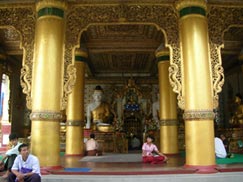
So called because, like the Western Entrance Hall, it was constructed in 1914 by daily contributions of two pices (1/32 of a rupee) from the shopkeepers of the old Strand Market which was managed by the Yangon Municipality. The central image of the buddha in the hall has the reputation of granting boons and devotees come here to pray before the image and to lift the stone in front of it, the stone becoming light if the prayer is to be granted.
The Tharrawaddy Min Bell (Maha Tissada Bell)
The King Tharwaddy’s Bell was the donation of King Tharwaddy of Ava (1838 – 1846) after his visit to Rangoon in 1841-42. The bell was cast on 19 February 184 and bears the Pali name Mahatisaddaghanta, “Great Bell of Three Sounds”. It is the second largest bell in Myanmar (the first being the Mingun Bell near Mandalay). It weighs 42 tons and 14 feet 3 inches in height, 7 feet 2 inches in width at the mouth and 15 inches in thickness. The bell has an inscription of 100 lines in Burmese and Pali. This inscription is the longest bell inscription in Myanmar.
The Tharrawaddy Min Bell (Maha Tissada Bell).
The gilt serpent dragon crawling along the hall column of Tharrawaddy Min Bell.
The gilt serpent dragon crawling along the hall column of Tharrawaddy Min Bell.
The gilt serpent dragon crawling along the hall column of Tharrawaddy Min Bell.
The intricate designed hall column of Tharrawaddy Min Bell.
The intricate designed hall column of Tharrawaddy Min Bell.
The intricate beautiful ceiling designs of Tharrawaddy Min Bell.
At the Tharrawaddy Min Bell (Maha Tissada Bell).
The East main shrine – Temple of the Kakusandha Buddha
Eastern Main Shrine (Eastern Devotion Hall) was built by Ma Mya Kalay, wife of King Tharyarwaddy of Ava, and was renovated by U Kalagyi in 1869.
Eastern Main Shrine (Eastern Devotion Hall) was described as “the handsomest on the pagoda platform”.
The Buddha image in this Eastern Main Shrine is that of Kakusandha Buddha also known as Latpetlet (Latpatlat) Buddha, as well as other images in front of the main Buddha, is unusual in which the right hand is turned upward, not the usual downward posture. (Lapatlat in Burmese means upward turned hand).
Night view of Shwedagon Pagoda
We all waited for the sunset view of Shwedagon Pagoda. Get a look at the golden stupa of the 2,500-year-old Shwedagon Pagoda at night and the stupa being lighted up with various lights.
We all waited for the sunset view of Shwedagon Pagoda. Get a look at the
golden stupa of the 2,500-year-old Shwedagon Pagoda at night and the
stupa being lighted up with various lights.
Night view of Shwedagon Pagoda.
Night view of Shwedagon Pagoda. Looking at the
golden stupa of the 2,500-year-old Shwedagon Pagoda being lighted up with various lights.
Night view of Shwedagon Pagoda.
Night view of Shwedagon Pagoda.
Night view of Shwedagon Pagoda. Looking at the
golden stupa of the 2,500-year-old Shwedagon Pagoda being lighted up with various lights.
Night view of Shwedagon Pagoda spire blue light.
Night view of Shwedagon Pagoda spire blue light.
Day 12 (16.12.2009) Yangon to Kuala Lumpur
Today is our travelling day back to Kuala Lumur by MAS flight.
Last minute shopping at Yangon International Airport by Rosalind Wan and Veronica Wan.
L-R: Rosalind Wan, Veronica Wan, Ching Neng Bin, Catherine Oon, Ching Bee Geok, Betty Ching, Lim Kee Moon at Yangon International Airport.

Today is our travelling day back to Kuala Lumur by MAS flight.
MAS flight over Yangon.
MAS flight over Yangon.
Home Sweet Home! Taking some food int SS2, KL.
Total Expenses per person is RM1,711
605.00 – MAS return ticket per pax
400.00 – Food, entrance fees and others per pax
706.00 – Hotel and transport US209 x 3.3783 per pax
1,711.00
///










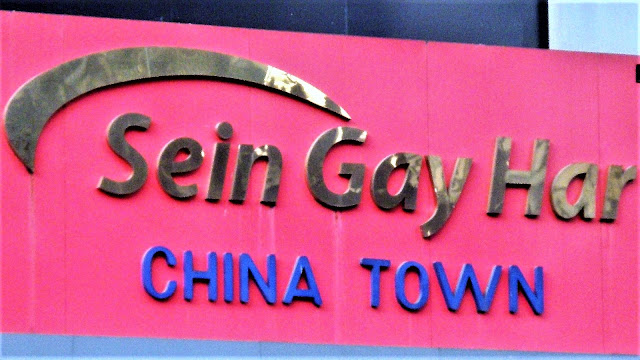












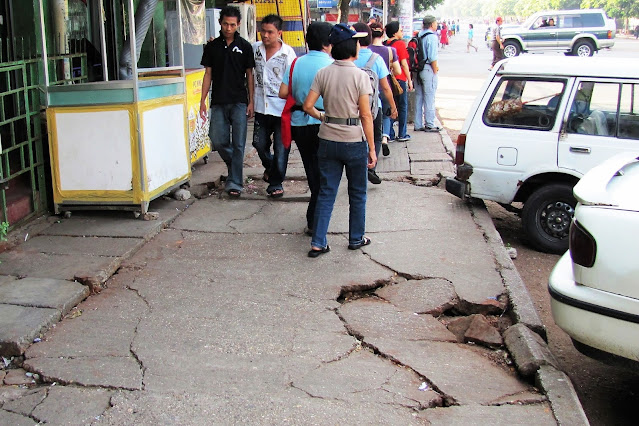












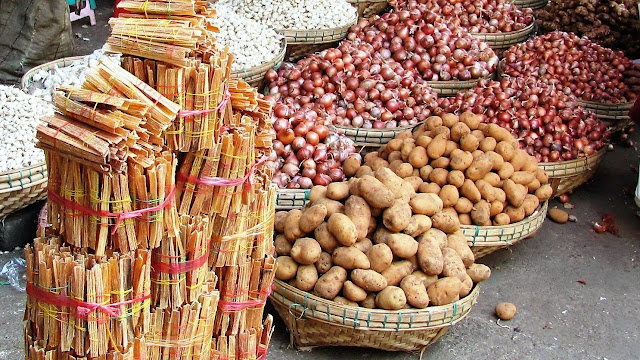



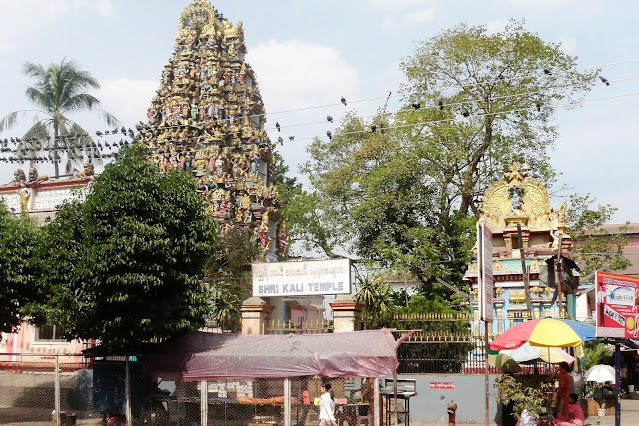

















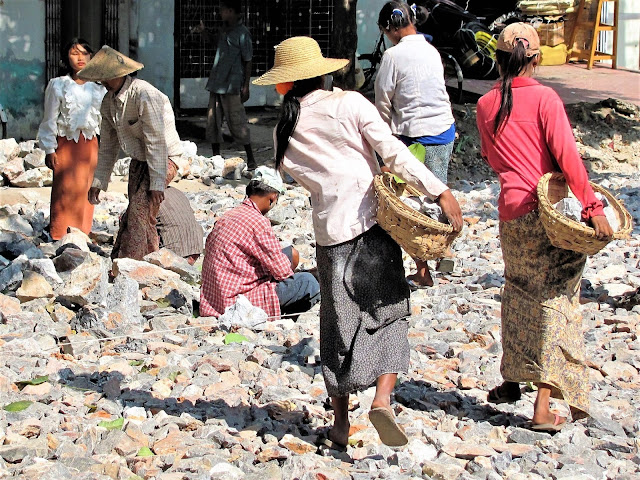















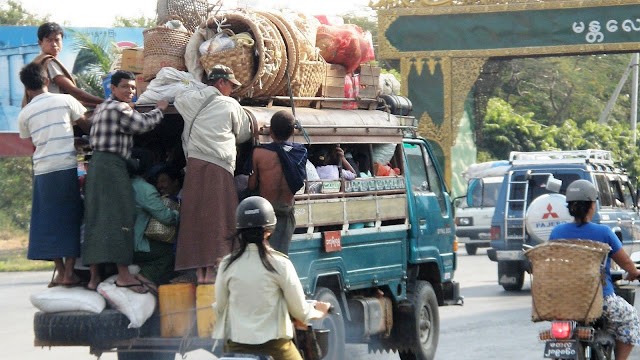







































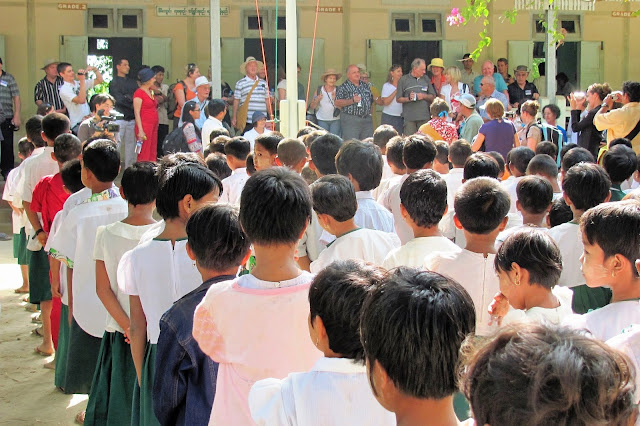







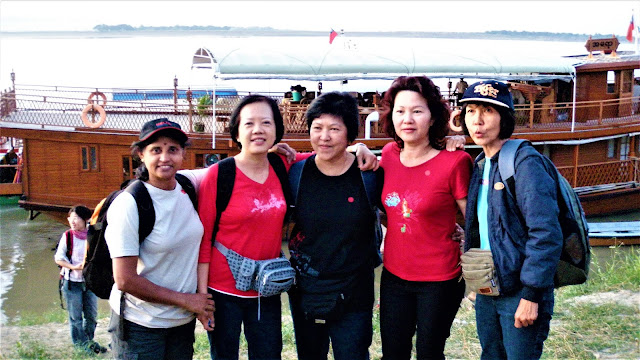




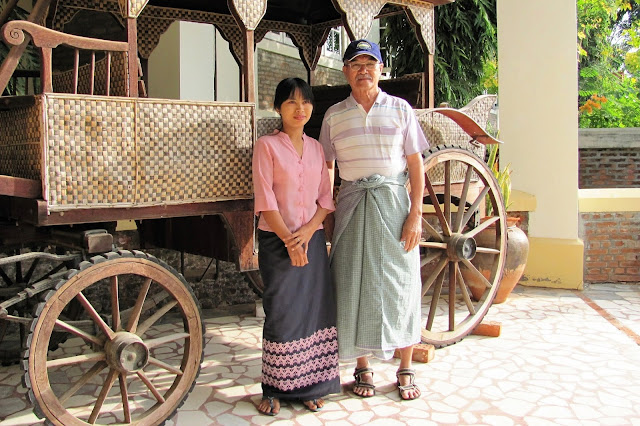


















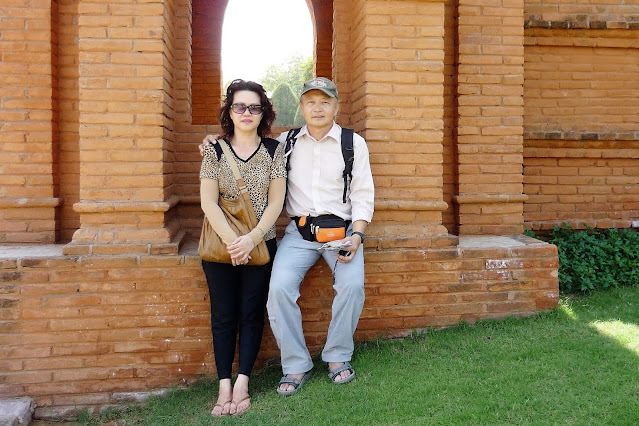









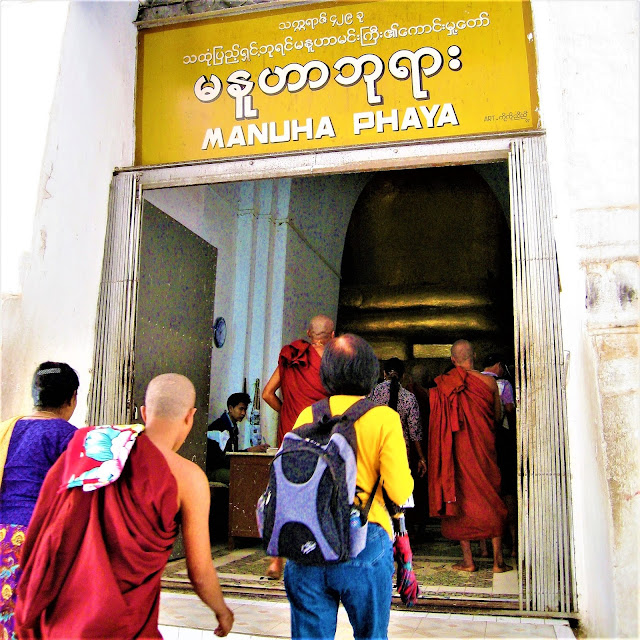





































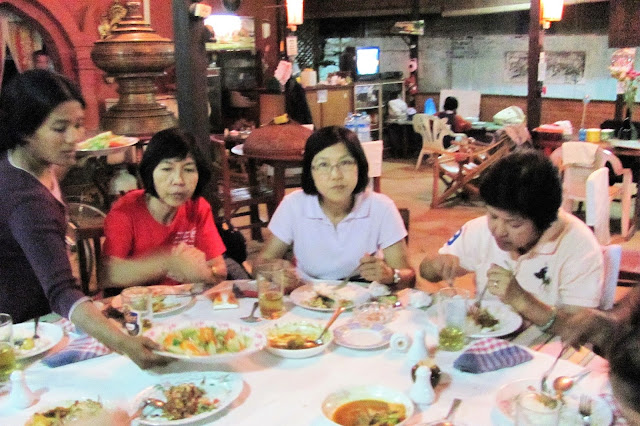











































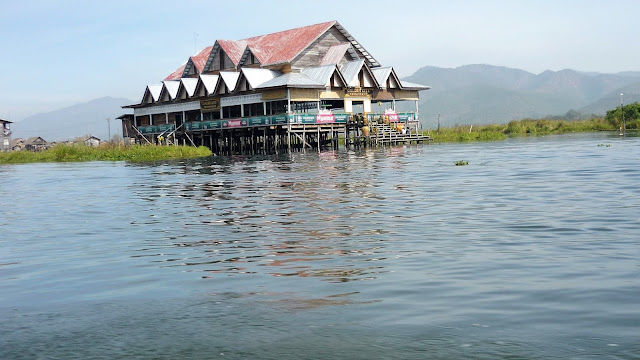

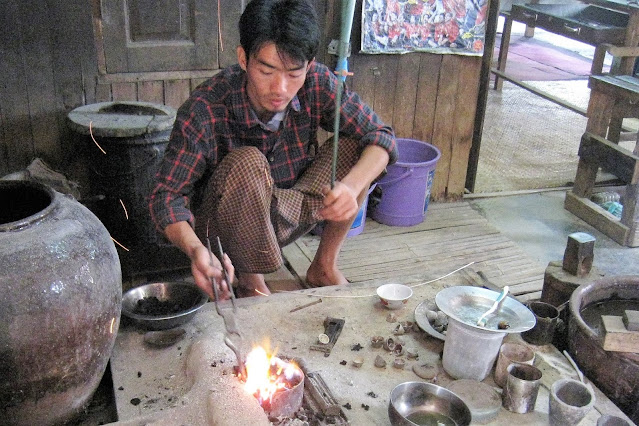




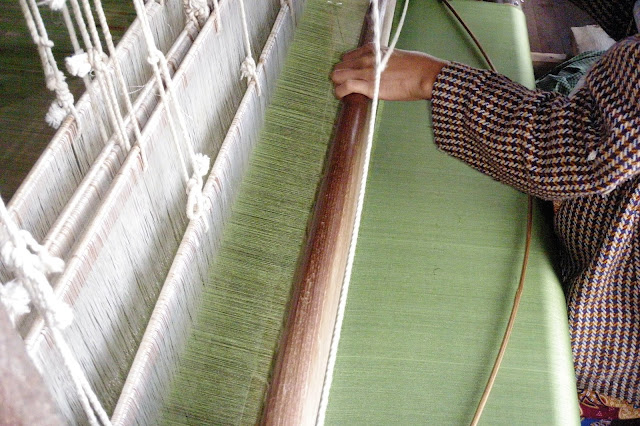




























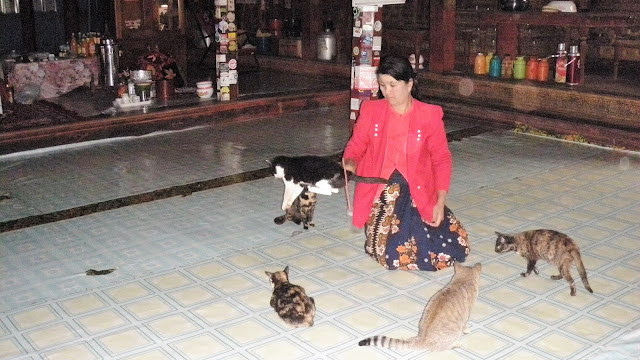



















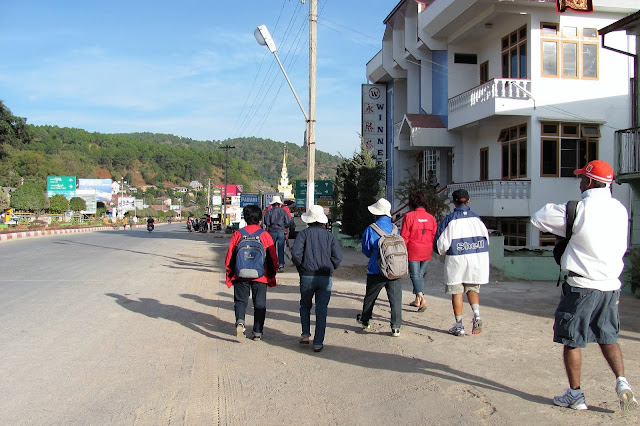


































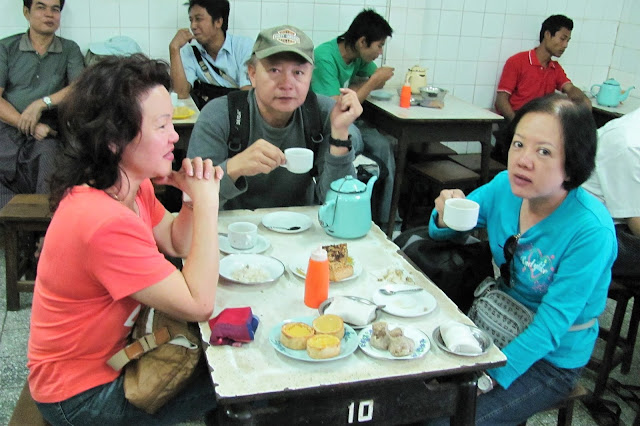



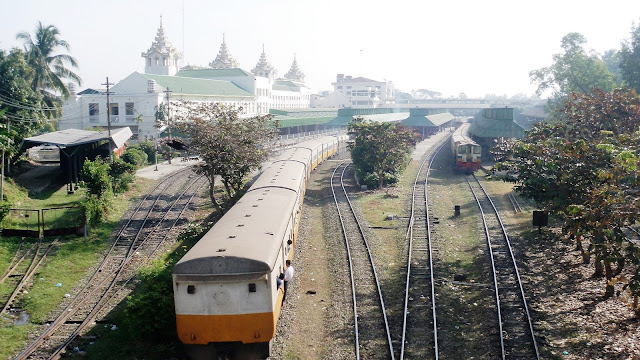












































































































Ching, you never run out of places to go...what a good life in retirement! Yeap Guan Leng
ReplyDeleteDear Mr Ching
ReplyDeleteVery beautiful pictures indeed and some can also be submitted for the Grammy Awards.
I have been to Yangon in 1995 for work under Public Bank then and the places are really fantastic now. Thank you and best regards.
P/S I have been to Mondul Kiri which is about 500 km east of Phnom Penh last month and intend to travel to Koh Kong which is about 270 km west of Phnom Penh which is close to Thailand this weekend which is a holiday for all banks (Sat to Mon).
hey why don't you refer to this country by its real name, Burma?
ReplyDeleteHi Ching,
ReplyDeleteI have stayed in the same hotel Yangon - Panorama. Good shots.
Richard Tan
Simply a mystical country~thanks for your kind sharing. My wish is to join u & your group for sightseeing tour one day. May u continue to visit more interesting places and
ReplyDeleteshare with us your journey.
Dear Ching,
ReplyDeleteThanks for sending pics of your adventure in Myanmar. Please come visit next time. There are many more exciting places still to be visited in Myanmar. Such as East eg. Shan State , North Myikyina and West Rakhine State etc.... Meet and talk to the people there.
Regards
Dr. Tin Tun
Hi,
ReplyDeleteThank you for sharing your experiences and photos of your trip to Myanmar. I'm looking forward to backpacking in Myanmar one day.
You may visit my blog http://mymountainadventures.blogspot.com.
Regards,
Shaun
Ching ,
ReplyDeleteThks for sharing . Wished could hv followed ur group . Supposed to visit Rangon way back in 1969 for SEAP Games but gave it the pass becos of exams .
A fantastic place to visit is the Galapagos lslands , Ecuador .
Great photography, I enjoy viewing - what is on the card for 2010. Thanks Bob Lim
ReplyDeleteChin,
ReplyDeleteI will not go to a country which is not democractic to people even though the place is nice and beautiful.
thanks for sharing your experience with me.
Dear Ching,
ReplyDeleteI'm very impressed with your file keeping on all your adventures and the detailed reporting of all your trips. Helen(our Philippines financial controller) has definitely picked up your file keeping. I'm sure many who have joined you on your trips will want do the same.
A brief intro, a family childhood friend; Katherine BK Chan. She is also impressed with your detailed reporting of your Myanmar trip and she wouldn't mind getting emails from you and keeping her in the loop with your future up coming trips.
Good night my friend and thanks for the many interesting emails you send me.
Song Poh.
Dear Ching,
ReplyDeleteMingalarbar! Greetings from Myanmar Tourex Travel - Yangon!
Thanks for the link & sharing your Fascinating Myanmar Trip. We are very happy to know that your group have great trip in Myanmar. This website will let more people know Myanmar, we will send the link to some of our clients who are interested and prepare to visit Myanmar.
Once again, Myanmar still have more place to visit hope to service you again soon.
Please do not hesitate to contact us for any further information or more assistance you may need.
Cheers!
Fannie
Hi,
ReplyDeleteSure you all have a enjoyable trip. Great pictures and documentaries. Live life to the fullest. Cheers
Ching..you organise the most interesting backpacking tours - wish could join u guys, perhaps next time :)
ReplyDeleteWarm Regards,
Calvin Yeoh
Mr. Ching,
ReplyDeleteThat was great.
See all your Mails.
Send Regards to Mr. Allen.
Best Regards.
Rama, OBA
Hi Ching
ReplyDeleteSo enthusiastic to read your journeys...............Will definitely get involve when I'm done with working.......if there are still slots left for me hahaha
Take care
Hock Lim
Public Bank
Thanks for all the info you send me without which I will not be well informed. Your info on Dengue very good. I use it on myself last year when dengue strike me. Cured by papaya leaves juice. Whenever I come about people who caught Dengue I tell them to use papaya leaves by word of mouth. Looking forward to read your blog on China trip.
ReplyDeleteHi Mr Ching
ReplyDeleteIts feel good just reading and looking all those photos you have posted especially after a hard day from my work. Thanks for the sharing and Wishing you and your family Gong Hee Fatt Choy. With Best Wishes & Regards Always.
Hi Ching,
ReplyDeleteJust back from Taiwan and finally got to see the Myanmar trip. Really fantastic photo's as usual and not at all what I expected to see. Looks like we will have to do it one day.
Your blog keeps getting better and better! Your older articles are not as good as newer ones you have a lot more creativity and originality now. Keep it up!
ReplyDeleteAnd according to this article, I totally agree with your opinion, but only this time! :)
Nice fill someone in on and this fill someone in on helped me alot in my college assignement. Thank you for your information.
ReplyDeleteTQ so much for sharing. Real nice photos taken & it must be a fantastic trip.
ReplyDeletehi ching,
ReplyDeletethanks for introducing me to your blog.its impreessive and inspiring.
thanks.
gunkl
Thanks for sharing. I will use the info for my travelling to Yangon on 5-13/11.
ReplyDeleteI admire your patience in documenting all your trips & you write very well too.
Personally, I just simply share my photos at facebook. Feel free to connect me at wongmunheng@gmail.com.
Thx again.
By the way, send my regards to my OBS course mates, Chew & Mohan.
Dear Mr. Ching Neng Bin,
ReplyDeleteMy name is Oh Teik Hean and I am from Teluk Intan, Perak. I came across some of your postings on travels and adventures and am really impressed. My friends and I who are in our sixties are interested to visit Myanmar. We hope that with your vast experience, you may be able to provide us the name of a reliable and reasonable travel agency to contact. We also hope that you can give some travel tips and advice if it is not too much to ask for.
Thank you.
(teikhean@yahoo.com)
Hi Teik Hean,
ReplyDeleteGlad to know that you are interested to visit Myanmar. Well, you can always follow how we traveled, i.e. get a tour co. to arrange local transport and hotel for your group. If your group is more than 5 members, you pay US209 each for the 10days arrangement. Other than transport and hotel, everything is at your own expenses.
The tour co. is Myanmar Tourex and the email: Web: WWW.myanmartourex.com, Email: (mtourex@gmail.com)
Do not hesitate to contact me if your have any questions. My HP 012-5053199
thanks for your info i am going next year july.. need minimum how many people? i only have 3 people here can i get a price like urs.. can it be cheaper i dont mind staying in low class hotel:)
ReplyDeleteIS there any minimum number of people to get this price?
ReplyDeleteMr Wooi, If you have the time, do it yourself by getting the local bus and the guesthouses. It would be very cheap to travel that way. My email is : ching2662@yahoo.co.uk.
ReplyDeleteThanks for sharing your detailed tour, Mr Ching.
ReplyDeleteI came across your blog when I was googling for backpacking tours to Myanmar.
Regards,
Irene Su
Thanks Ching. Wow!..........real impressive. The way you presented the trip is so informative. Anyway, there are 3 in the group. We will be arriving in Burma on 10/4 morning and flying back on 19/4 morning. We have exactly 8 full days in Burma. Since small group, is it better to do it on our own? Can you plan an itinerary for us for the 8 days? Yangon - Mandalay - Bagan was my original plan or is better to replace Mandalay with Inle? Pls advice.
ReplyDeleteAgain thanks a lot. Take care
Bala
This place is mind-blowing. All the pictures are beautiful. Thanks for sharing.
ReplyDelete